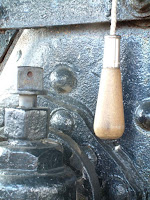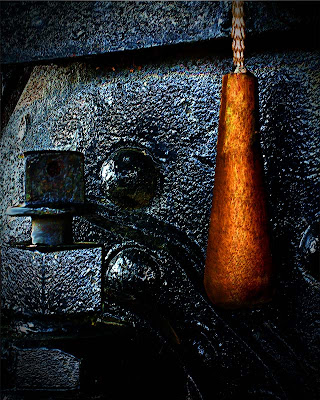
 Today's image (the large shot on the right) started with the small image on the left. I can think of a dozen things that needed to be done to get from one to the other. The first thing that is quite evident is "how" a camera's meter reads a scene. You can see the proper color in the finished image. The inside of the cab of the old steam train is painted black. The camera's sensor was pointed directly at a large black mass. It did a great job of trying to produce an 18% grey. Lately I've seen a lot of ink talking about "exposing to the right". Well, that's exactly what the camera's meter did in this case. It really had no choice. It has no intelligence, it's there to "record" what's in front of it, period. It did a fine job doing what it was asked to do. Is the original a "work of art"? No, it's a place to start, it's the negative from which we can start the image making process. The first thing that needed to be done was to straighten up the image. In the original you can see the handle cord hanging on a slight angle. It's unnatural, so we can use that to square up the image. To learn about a couple of the other things this image needed to fully develop, hit the "read more".
Today's image (the large shot on the right) started with the small image on the left. I can think of a dozen things that needed to be done to get from one to the other. The first thing that is quite evident is "how" a camera's meter reads a scene. You can see the proper color in the finished image. The inside of the cab of the old steam train is painted black. The camera's sensor was pointed directly at a large black mass. It did a great job of trying to produce an 18% grey. Lately I've seen a lot of ink talking about "exposing to the right". Well, that's exactly what the camera's meter did in this case. It really had no choice. It has no intelligence, it's there to "record" what's in front of it, period. It did a fine job doing what it was asked to do. Is the original a "work of art"? No, it's a place to start, it's the negative from which we can start the image making process. The first thing that needed to be done was to straighten up the image. In the original you can see the handle cord hanging on a slight angle. It's unnatural, so we can use that to square up the image. To learn about a couple of the other things this image needed to fully develop, hit the "read more".The first step is to decide what's a keeper and what can be dropped out. In order to hold the viewer in the shot the upper and lower right corners could be brought down to black. The upper left could be burned in, but not quite to black. A little detail needs to be there to allow the viewer to "enter" the shot. The same goes more the lower left. Without detail there would be no image. You can't have a complete black ring and expect someone to be able to jump into the middle.
Take a look at the left face of the square bolt in the original. See anything? I didn't either. It had to be rebuilt from other areas. The texture had to just about match other surfaces without looking like just a cut and paste job. Once the basic textures were brought in to form the side of the bolt, burning and dodging was used to sculpt the entire bolt. Attention to detail is a must for this type of shot.
Next, check out the handle of the whistle pull. No matter how far down the tone was brought I just couldn't get detail on the left side of the wood. If you look carefully you see light coming from two directions. The general light on the scene is left to right. The light on the handle appears to be on center. To create the left half of the handle, the right half was duplicated, flipped and aligned. The metal ferrule on the handle proved to be too difficult to rebuild convincingly, so it was eliminated and the handle made to look like it was all wood. Again, dodging and burning was used to make the two sides appear different from one another. The horizontal stripe of darken wood was added to give the impression of the placement of the engineers hand over and over again for many years.
The pull cord had to be built for scratch, using the original as a guide for placement only. One side was made, duplicated, offset by one thread and put together.
To put just a little color into the composition the area just above the bolt head was "rusted" by the introduction of a hint of red.
Without a fairly high amount of sharpening (using the High Pass filter technique) the texture wouldn't show properly. The vignette was discussed earlier and the "normal" Multiply technique was not used in this case.





0 comments:
Post a Comment